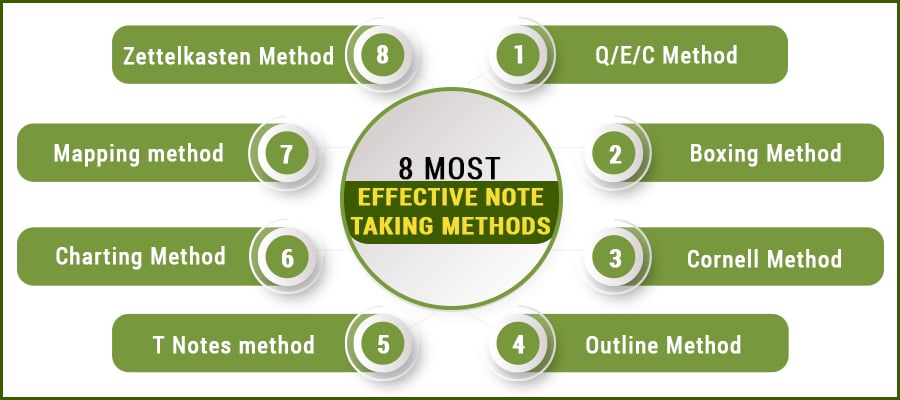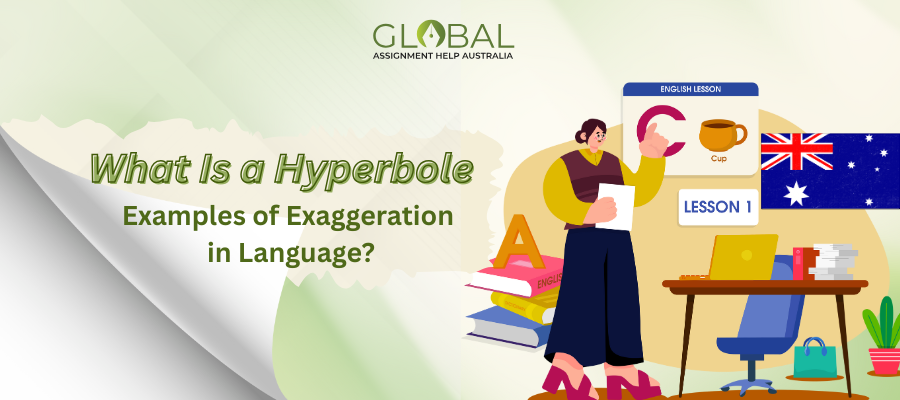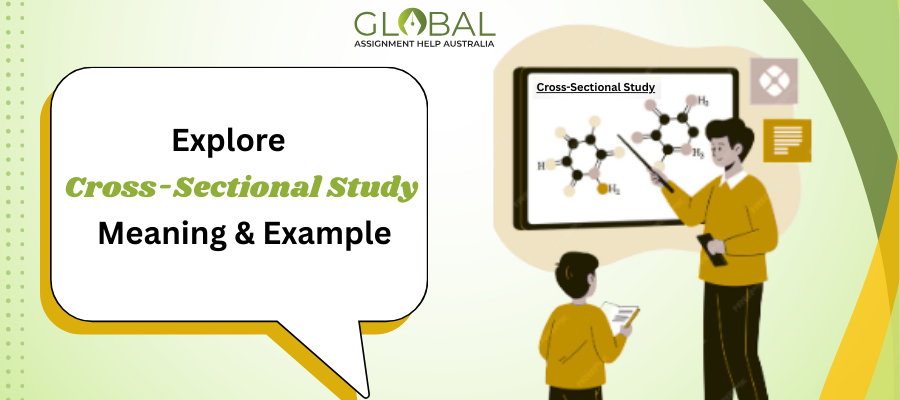 Offers
New
Order Now
Offers
New
Order Now
Note-taking is an essential activity for students. Whether you are researching content for your academic papers, understanding class lectures or remembering things.So, it is required by the students, but there are so many note-taking methods serving different purposes, which they are unaware of.
The lack of knowledge makes them search for online assignment help to form their notes. But if you want to become a pro at making notes, this blog is for you . As, it teaches you their meaning and purpose to build your base. Further, you read about the eight most effective note-taking methods to help you become the master of the subject. So, without any delay, let us begin.
Get Help NowNote-taking helps one understand, remember, and retrieve any piece of information. So note-taking methods are the techniques or steps one executes to make notes to fulfil their academic objective. Further, you may require different methodologies that serve different purposes for the students. You select them based on your requirements. But you may ask, which is the best? There is no specific answer to that, as each method has its pros and cons and is apt in certain situations. So, the best technique depends on your need. In last, the note-taking methods help to:
So, it is all about the meaning and purpose of note-taking methods. Now is the time to read about the eight most effective techniques to make notes.
Here are the eight best note-taking methods. The upcoming content teaches you about each technique in depth. You learn about their pros and cons and specific purposes. But even if you choose a method to make notes and write your final content, you still have to edit it for perfection. For that, you can use our free grammar checker tool to remove any spelling and punctuation errors.

The full form of the QEC method is Question, Evidence, and Conclusion. It is an effective technique to grasp complex concepts of the lecture that you are attending. You do it by forming a question related to the concepts you are studying and presenting arguments and evidence to answer it. After that, you write a summary at the page end to conclude your main points to help you retain the information.
Best Situation: Understanding concepts of argumentative subjects like history, literature, and science.
Pros:
Help you build relationships between different connected concepts.
An effective way to record the arguments.
Useful way to outline argumentative essays.
Cons:
Less suitable for nontechnical subjects.
Ineffective when you are attending a fast-paced lecture.
It requires one to concentrate fully.
The boxing method is effective for note-taking when you learn visually. You make boxes and connect them with a straight line to make the notes. Further, use it while revising certain concepts and topics. But how to make it? You will first create a box on a page of a sub-topic or section with its heading. Then, you write its related pointers inside that box and you do same for others. This technique was invented by a Goodnotes user, as the app helps one create boxes and lines without using a ruler.
Best Situation: When you learn better visually and for revision of any concept.
Pros:
Best when you are revising a concept or topic.
It provides a summary of each lecture, chapter, or subtopic to read later.
This method gives one visually appealing note to revise later.
Cons:
Not an effective method when you have to make notes during a fast-paced meeting or lecture.
It can be difficult if you struggle with making boxes freehand.
It can be time-consuming to make it visually appealing.
The Cornell note-taking method is one of the most effective note-taking techniques developed by Prof. Walter Pauk of Cornell University in the 1950s. You make them by writing the title at the top of the page. Then, you divide the page into two vertical columns. On the left side, you write the keywords and question, and on the right, you write the main notes and ideas, usually in abbreviation. At the end, you write the summary of all the ideas shared.
Best Situation: Helps one to study and revise.
Pros:
Aid in extracting the main ideas of a topic.
Develop a deeper understanding of the subject by writing the summary.
It helps in revising later as your notes are logically organized and easy to skim.
Cons:
Take more effort and time to make these notes.
It requires some time to set up the page.
Not suitable when you have to add heavy terminology and statistics.
Homework Is Tough? | Hire Our Experts and Get Assistance Online in Any Subject.
The outline method helps to make notes concisely, just like you make one for writing an essay or speech. You use it because it is more visually appealing and helps one to organize the points better. You do it by writing a main topic and adding its nested bullet points below it to convey the related ideas. Ensure that you use short sentences per point. Further, you add the information in hierarchical form. The most important one coming at the top, and less essential at the bottom.
Best Situation: When you have to jot down the pointers quickly in a meeting or lecture.
Pros:
Highlight the key ideas of the topic.
Allows you to connect related ideas.
Makes your notes highly visual and appealing.
Cons:
Not great when you have to add too many diagrams or visual
It may result in taking too many notes.
You can only make notes when the lecture is organized.
If you are looking for a technique to structure your notes, then the T note-taking method is best for you. Further, it aids in making notes quickly when you are in a lecture or meeting. Under this, you write your main topic at the top of your page. Then, divide the page into two columns by marking a line in between. On the right side, you will write the main questions, equations, or formulas you learned. Then, on the left, you write their explanation.
Best Situation: When you have to organize notes quickly of numerical subjects.
Pros:
Helps in organizing large amounts of data.
Make it easy to check and retrieve the information.
Best to make notes for math or statistics.
Cons:
Can be a bit tricky when you are new to this method.
It may take some time to formulate the grid for your notes.
It does not allow space for creativity, as the format is rigid.
The charting method is a great technique to organize when you have a lot of data to add. As the name suggests, you create a chart on the paper containing various rows and columns. Its left column and top row provide the headings of the topic, and the rest cells provide relevant data. You cannot use this method while you are in a quick lecture until it provides information in the same organized manner.
Best Situation: It is best to write data in each cell, which has a lot of similar characteristics, like that of the chemistry periodic table.
Pros:
Great when you have to compare similar types of data.
Provides you with a systematic arrangement of data.
Easy to revise when you have a large amount of data.
Cons:
Not apt with most subjects.
You have to understand the topic to use the charting method for its content.
It requires the highest amount of time than most of the methods.
The mapping method is also known as concept mapping. Under this, you write the heading of a main topic in a circle. Then, you take branches out of it and explain its sub-topics by jotting down their headings and pointers. For instance, you write an electric motor in the middle and explain its use cases and working model steps by crafting branches out of the centre circle.
Best Situation: It is best when to write a lot of information for each sub-topic and study something using the fey-man technique.
Pros:
Easy to create and write a lot of information quickly.
Help to establish relations between different sub-topics.
You can convey a lot of pointers without cluttering the page.
Cons:
You may have to use a lot of pages because of the extensive explanation.
It requires one to fully grasp the topic before using this method.
Mapping is a time-consuming process.
The Zettelkasten note-taking method helps when you have to accumulate knowledge about a topic. It is not suitable when you have to take notes quickly, but very apt when you have to gather information over a topic for a specific time. Under this method, you write all your learning and ideas over a topic on a card (a “Zettel”) and put all that in a box (a “Kasten”). You do this process over a year or 6 months, you will become master on a topic.
Best Situation: You cannot use this method to take notes for your chemistry lecture, but it works well when you have to complete your science degree.
Pros:
A great technique to build a knowledge base for a topic.
It helps you revise regularly.
It makes your notes easy to revise, as they are concise.
Cons:
Can consume time to set up when you have to take notes digitally.
Organizing different notes requires effort.
If you store physical notes, the page quality may degrade over time.
It is all about the note-taking methods. The blog first discusses the meaning and purpose of them. Then, it covers the eight most effective note-taking methods to help you know which to choose for your work. But if all these sound complex, you can search for global assignment help Australia to get the aid of experts to make notes for your papers. The professionals are the masters in formulating academic notes. So, you do not have to take any tension if you assign them any of your tasks. Since they have years of experience in note-making, be assured of the quality.
You May Also Like To Read-
How to Write a Speech: Helpful Tips to Engage Your Audience

Grab this exclusive offer and start your journey to savings today! Act quickly, as this special offer won't be around for long!

This blog explains what is a hyperbole, provides engaging examples, & explores how to use hyperbole.

Explore 150+ funny debate topics to spark laughter, creativity, and lively discussions in 2025

Cross-Sectional Study basics explained with steps, examples, and comparisons.
Limited Time Offer
Exclusive Library Membership + FREE Wallet Balance
1 Month Access !
5000 Student Samples
+10,000 Answers by Experts
Get $300 Now
Update your Number

